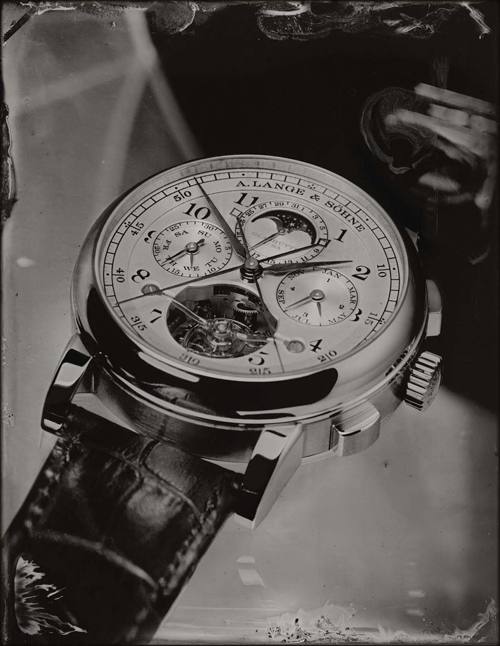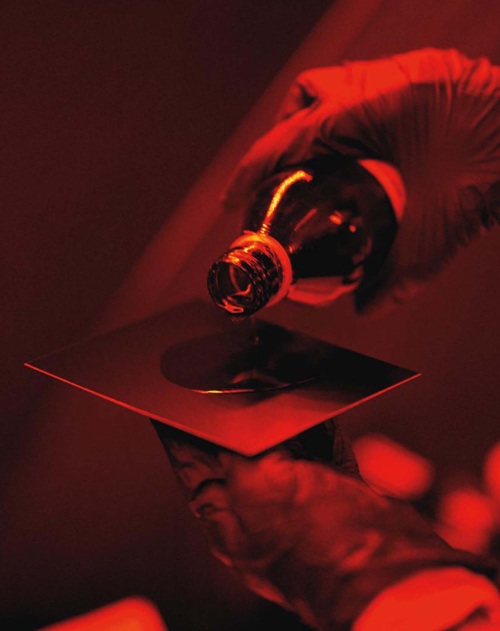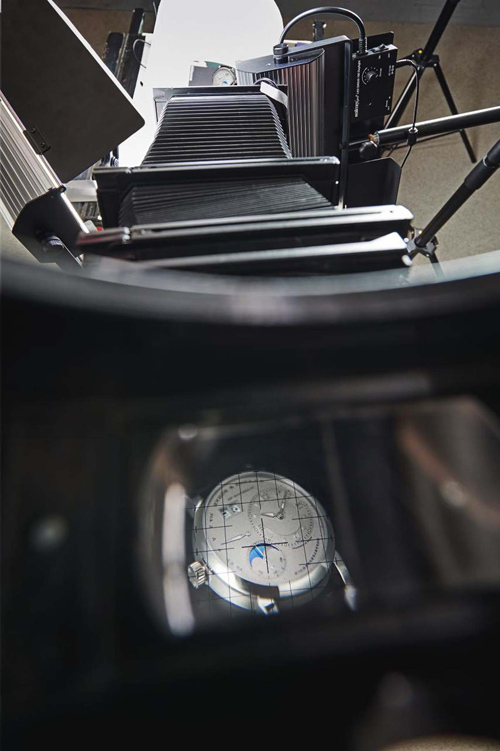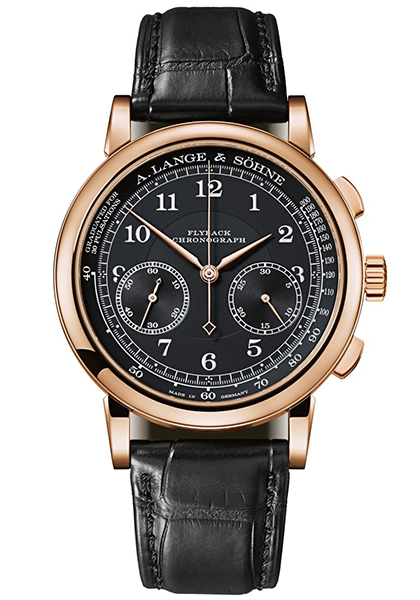In the search for a photographic technique that reflects the traditional crafts of the manufactory and simultaneously offers new forms of expression, A. Lange & Söhne made use of the collodion wet-plate process for the first time. Like the manual precision required in the manufacture of every Lange timepiece, the traditional wet-plate process similarly demands the ultimate in patience, care and attention to details. Everything in the collodion wet-plate process is done by hand. This elaborate process was invented in 1851 by the British pioneer of photography Frederick Scott Archer. The method relies above all on the order in which the processes are performed and on very precise timing. The enormous effort involved is rewarded by the incomparable visual signature of the resulting image. This is how the unique portraits of the new timepieces created in 2017 were made.
The slow and painstaking, step-by-step method leads, at most, to only a few photographs each day. However, the results are impressive images that perfectly mirror the contemplative work process and the desire for historic authenticity. At a three-day studio session in early December, seven of the new Lange timepieces for 2017 were captured on glass plates with this historic technique:
– the Tourbograph PerpetualL “Pour Le Mérite” combining five complications in a masterpiece of precision watchmaking
– the Lange1 Moon Phase with an integrated day/night indicator
– the distinctively classic 1815 Annual Calendar
– the Richard Lange JumpingG Seconds with a one-second constant-force escapement
– with an impressive 31-day power reserve, the Lange 31 in white gold with an elegant grey dial
– the Little Saxonia with a mother-of-pearl dial

© A. Lange & Söhne
Photographing the new timepieces entails a process similar to previous studio sessions – at least in terms of preparing the motif. As usual, the key tasks involve finding the ideal position for the timepieces, providing the perfect lighting as well as ensuring optimum focus and the desired depth of field. What is special about this historic technique are the complicated steps of the procedure that are essential for every single photograph taken: the meticulous preparation of the glass plates and the developing process in the laboratory.
In a first step, a glass plate is coated with collodion, a liquid photosensitive base. This is made by dissolving cellulose nitrate in ether and alcohol and subsequently adding a soluble iodide. Around a dozen different chemicals are used in the process before the finished image can be seen.

© A. Lange & Söhne
In the darkroom, the coated plate is dipped into a dish containing silver nitrate solution. In this phase, the iodine salts are chemically replaced by light-sensitive silver iodide and silver bromide particles that are evenly distributed in the collodion coating. The wet plate prepared in this way is placed in a light-tight plate holder and slid into the camera.
The low sensitivity of 1 to 2 ASA demands exposure times of several minutes or an extremely strong source of light. Exposing the plate to light initiates a chemical reaction in the light-sensitive coating, the results of which first slowly appear in a developing bath in the red light of the darkroom.
As the process only works while the plate is still wet, the exposed plate must be developed immediately. If the plate dries out, the enormous effort is wasted. Depending on the ambient temperature, the photographer must complete the entire process from coating the plate to developing the final image within a period of only five to fifteen minutes.
After developing, the images must be fixed, watered and dried before they can be coated and made ready for subsequent scanning. The effort involved is amply rewarded. The results are unique and almost magical photographs with impressive contrast and brightness that seem to be from another age. Photographs made by the collodion wetplate method can be enlarged to many times their original format without any loss of sharpness.
One opinion to rule them all…Having a wristwatch of these characteristics in your hands or in your wrist, even if it’s just for a few minutes, makes it hard to keep your journalistic objectivity intact. Please excuse me if the next post becomes lyrical and enthused… that’s the effect a watch like the A. Lange & Söhne Triple Split may have to a watch fan. But before that, I have to ask a very simple question: Why Is the Triple Split useful? And the response is: No! This watch has just no rational function. The Dual Split was a demonstration of desirable inutility and the Triple Split follows the exact same path. Do not get me wrong, however. I say so with all due respect and a lot of affection. This watch is in Precisely the Same vein as a Lamborghini Aventador SV or even a Bugatti Chiron. Impossible to use on the street yet oh-so-essential in the same time. That having been said, let’s take a look at this bit of pure “watch eroticism”.What is a split? What is a double split? And more importantly, what is a triple divide? Or in short, why’s the ALS Triple Split THE most complex chronograph ever created?Once upon a time, watchmakers made a tool named the chronograph — or the stopwatch (using plenty of queries about who really created it — Nicolas Rieussec or Louis Moinet). They had been created in order to figure out the length of an occasion, from its start to its end. Whether they are now utilized to assess the cooking period of your own pasta or the duration of a meeting, their first goal was to time races.

© A. Lange & Söhne


